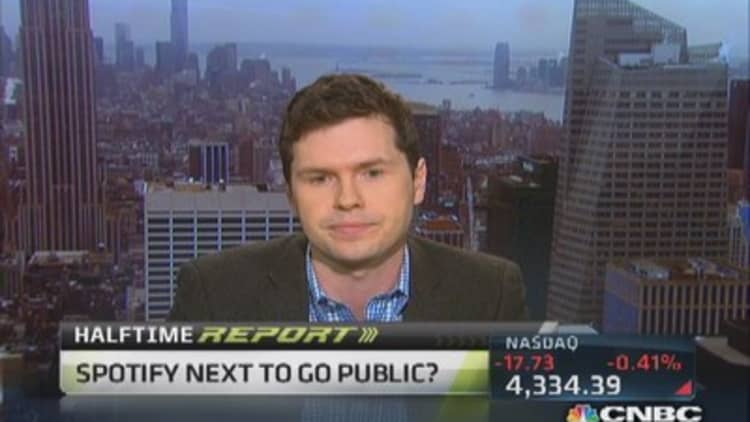Now that Spotify has over 50 million people in 58 countries using its online music service, the company is doing its best to tell those listeners which up-and-coming artist will be the next big thing.
"One of the things we use data for is to really understand—and we believe we've gotten pretty good at this—what artists or what songs are going to be hot," Jeff Levick, Spotify's chief business officer, said Tuesday at the Appnation conference in Las Vegas. "We put a lot of our energy and time behind these artists and behind these songs to promote them."
Levick, speaking in an on-stage interview with CNBC.com, said the company's in-house talent hunters look for lesser-known musicians that are seeing spikes in engagement on the service to help determine "if this is something that's going to catch fire." At that point, Spotify reaches out to the artists' managers to work on accelerating the growth.
Read MoreTaylor Swift's problem with Spotify
Artists that have gained a following on Spotify before blowing up globally include pop-star Lorde out of New Zealand and Ireland's Hozier.
Using technology and data to predict artist success is one way Spotify is aiming to differentiate itself in a crowded online music market that's rapidly moving to mobile. Internet radio service Pandora is built on algorithms that guess what consumers want to hear, and Apple is going beyond paid downloads by offering an iTunes Radio service.

Like Pandora, Spotify is burdened by a cost structure that requires it to send huge chunks of revenue back to the music industry. About 70 percent of Spotify's music sales go to artists, labels and publishers. Chief Executive Officer Daniel Ek wrote in a blog post in November that the 7-year-old service has paid out over $2 billion to the industry, with about half of that coming since 2012.
Spotify is still privately held, so it's financials remain under wraps, but it's a big challenge for any company to make money when it only keeps 30 percent of its revenue. Pandora, which is publicly traded, spent 46 percent of its sales on acquiring content in the period ending in September, resulting in a $2 million net loss.
By supporting artists and helping them sell merchandise and generate buzz for their tours, Spotify is trying to boost its user base while cozying up to an industry that has taken to viewing the digital transition as an economic threat.
"We believe in paying back the ecosystem," Levick said.
More than half of Spotify's usage is on mobile devices, and about a quarter of its customers are paying for subscriptions, with the rest opting for the free ad-supported service. For an unlimited song catalog with no ads, Spotify charges $9.99 a month.
Read MoreBMW connects with Spotify
Levick, who works out of Spotify's New York office, is in Las Vegas this week for CES, the annual consumer electronics trade show, as well as for Appnation, which is being held alongside the giant event. Levick said CES is great for Spotify, because the company's product is being featured by partners such as Ford, BMW, Samsung and Bose.
"While we don't exhibit on the floor, Spotify is everywhere," he said.


